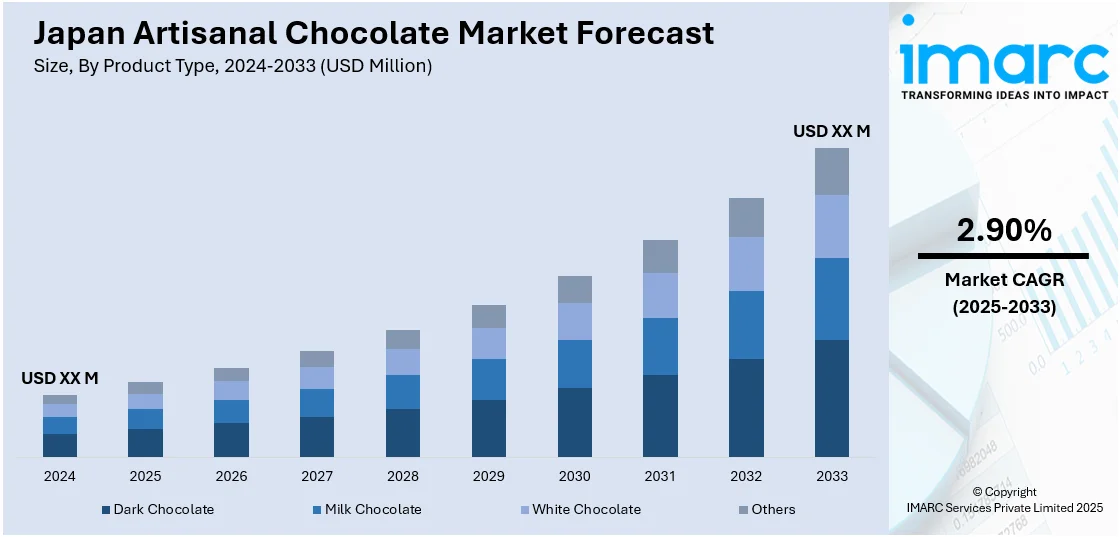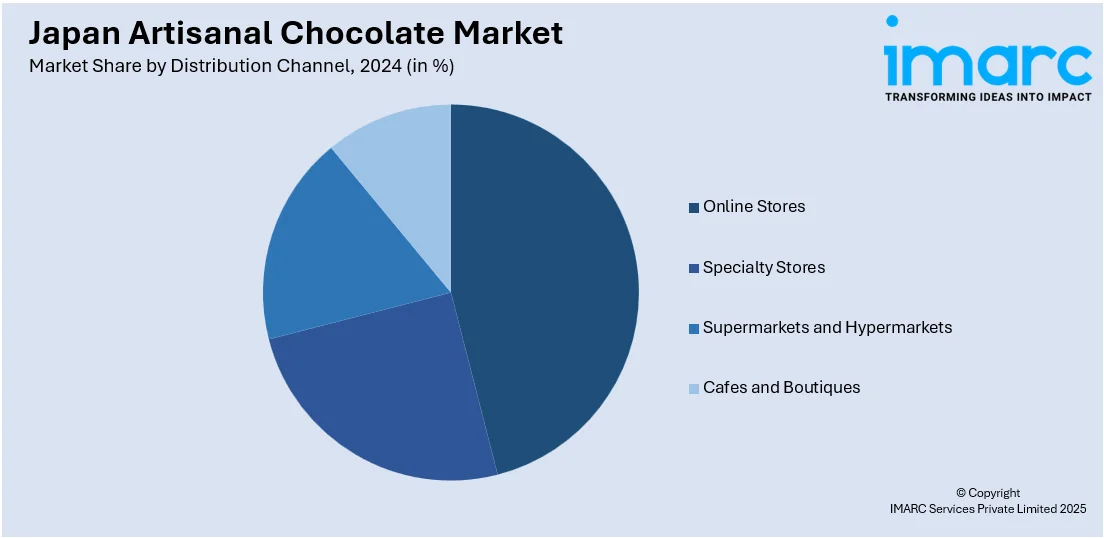
Japan Artisanal Chocolate Market Size, Share, Trends and Forecast by Product Type, Ingredients, Distribution Channel, Consumer Demographics, Application, and Region, 2025-2033
Japan Artisanal Chocolate Market Overview:
The Japan artisanal chocolate market size is exhibiting a growth rate (CAGR) of 2.90% during 2025-2033. The market is witnessing steady growth, driven by evolving consumer tastes favoring premium, handcrafted chocolates with unique flavors and ingredients. Rising interest in ethical sourcing, sustainability, and bean-to-bar craftsmanship that enhance the appeal of artisanal products, and the growing gifting culture, influence of Western dessert trends, and expanding specialty retail outlets also contribute to market expansion. Innovation in packaging and product storytelling further captivates consumers, boosting the visibility and competitiveness of the Japan artisanal chocolate market share.
|
Report Attribute
|
Key Statistics
|
|---|---|
|
Base Year
|
2024 |
|
Forecast Years
|
2025-2033
|
|
Historical Years
|
2019-2024
|
| Market Growth Rate 2025-2033 | 2.90% |
Japan Artisanal Chocolate Market Trends:
Rising Demand for Premium and Craft Chocolate Experiences
Japanese consumers increasingly seek premium chocolate products that emphasize craftsmanship, authenticity, and exceptional quality. Artisanal chocolates, often made with carefully sourced ingredients and presented with artistic finesse, align with these expectations. The appeal of small-batch production methods, attention to detail, and personalized touches differentiates artisanal chocolate from mass-produced alternatives. This demand is reinforced by Japan’s strong gift-giving culture, where luxurious and aesthetically pleasing chocolates are highly valued for personal and corporate gifting occasions. As a result, local and international chocolatiers are responding by offering innovative flavors, limited-edition collections, and bespoke services, enhancing the market’s premium appeal and contributing to the sustained growth of the Japan artisanal chocolate segment.

Growing Influence of Global and Local Culinary Trends
Japanese consumers are highly influenced by both global culinary movements and local food culture, fostering a sophisticated taste for unique chocolate experiences. Exposure to international trends such as bean-to-bar, ethical sourcing, and single-origin cacao has heightened awareness and demand for artisanal chocolate that tells a story of origin, process, and sustainability. Simultaneously, local culinary preferences for delicate, balanced flavors and seasonality influence the creation of innovative chocolate offerings infused with Japanese ingredients such as matcha, yuzu, and sakura. This blending of global and local influences drives chocolatiers to experiment creatively, offering products that appeal to refined Japanese palates while satisfying curiosity for diverse and culturally enriched chocolate experiences.
Expansion of Specialty Retail and E-Commerce Platforms
Japan’s dynamic retail landscape, including high-end department stores, specialty boutiques, and pop-up events, offers artisanal chocolatiers premium platforms to showcase their products. Gourmet chocolate fairs and seasonal events such as Valentine’s Day chocolate festivals attract significant consumer interest, providing opportunities for artisans to engage directly with customers. Additionally, the rise of e-commerce and online specialty platforms enables artisanal chocolate brands to reach wider audiences beyond urban centers. Digital platforms offer curated selections, storytelling, and gifting services, enhancing the accessibility and appeal of artisanal chocolates. This omnichannel approach supports the Japan artisanal chocolate market growth by combining immersive in-store experiences with the convenience of online purchasing, appealing to both traditional and modern consumer preferences.
Japan Artisanal Chocolate Market Segmentation:
IMARC Group provides an analysis of the key trends in each segment of the market, along with forecasts at the country and regional levels for 2025-2033. Our report has categorized the market based on product type, ingredients, distribution channel, consumer demographics, and application.
Product Type Insights:
- Dark Chocolate
- Milk Chocolate
- White Chocolate
- Others
The report has provided a detailed breakup and analysis of the market based on the product type. This includes dark chocolate, milk chocolate, white chocolate, and others.
Ingredients Insights:
- Organic and Natural Ingredients
- Conventional Ingredients
A detailed breakup and analysis of the market based on the ingredients have also been provided in the report. This includes organic and natural ingredients, and conventional ingredients.
Distribution Channel Insights:

- Online Stores
- Specialty Stores
- Supermarkets and Hypermarkets
- Cafes and Boutiques
A detailed breakup and analysis of the market based on the distribution channel have also been provided in the report. This includes online stores, specialty stores, supermarkets and hypermarkets, and cafes and boutiques.
Consumer Demographics Insights:
- Premium
- Mass
A detailed breakup and analysis of the market based on the consumer demographics have also been provided in the report. This includes premium and mass.
Application Insights:
- Direct Consumption
- Bakery and Confectionery
- Beverages
A detailed breakup and analysis of the market based on the application have also been provided in the report. This includes direct consumption, bakery and confectionery, and beverages.
Regional Insights:
- Kanto Region
- Kansai/Kinki Region
- Central/ Chubu Region
- Kyushu-Okinawa Region
- Tohoku Region
- Chugoku Region
- Hokkaido Region
- Shikoku Region
The report has also provided a comprehensive analysis of all the major regional markets, which include the Kanto Region, Kansai/Kinki Region, Central/ Chubu Region, Kyushu-Okinawa Region, Tohoku Region, Chugoku Region, Hokkaido Region, and Shikoku Region.
Competitive Landscape:
The market research report has also provided a comprehensive analysis of the competitive landscape. Competitive analysis such as market structure, key player positioning, top winning strategies, competitive dashboard, and company evaluation quadrant has been covered in the report. Also, detailed profiles of all major companies have been provided.
Japan Artisanal Chocolate Market Report Coverage:
| Report Features | Details |
|---|---|
| Base Year of the Analysis | 2024 |
| Historical Period | 2019-2024 |
| Forecast Period | 2025-2033 |
| Units | Million USD |
| Scope of the Report | Exploration of Historical Trends and Market Outlook, Industry Catalysts and Challenges, Segment-Wise Historical and Future Market Assessment:
|
| Product Types Covered | Dark Chocolate, Milk Chocolate, White Chocolate, Others |
| Ingredients Covered | Organic and Natural Ingredients, Conventional Ingredients |
| Distribution Channels Covered | Online Stores, Specialty Stores, Supermarkets and Hypermarkets, Cafes and Boutiques |
| Consumer Demographics Covered | Premium, Mass |
| Applications Covered | Direct Consumption, Bakery and Confectionery, Beverages |
| Regions Covered | Kanto Region, Kansai/Kinki Region, Central/ Chubu Region, Kyushu-Okinawa Region, Tohoku Region, Chugoku Region, Hokkaido Region, Shikoku Region |
| Customization Scope | 10% Free Customization |
| Post-Sale Analyst Support | 10-12 Weeks |
| Delivery Format | PDF and Excel through Email (We can also provide the editable version of the report in PPT/Word format on special request) |
Key Questions Answered in This Report:
- How has the Japan artisanal chocolate market performed so far and how will it perform in the coming years?
- What is the breakup of the Japan artisanal chocolate market on the basis of product type?
- What is the breakup of the Japan artisanal chocolate market on the basis of ingredients?
- What is the breakup of the Japan artisanal chocolate market on the basis of distribution channel?
- What is the breakup of the Japan artisanal chocolate market on the basis of consumer demographics?
- What is the breakup of the Japan artisanal chocolate market on the basis of application?
- What is the breakup of the Japan artisanal chocolate market on the basis of region?
- What are the various stages in the value chain of the Japan artisanal chocolate market?
- What are the key driving factors and challenges in the Japan artisanal chocolate market?
- What is the structure of the Japan artisanal chocolate market and who are the key players?
- What is the degree of competition in the Japan artisanal chocolate market?
Key Benefits for Stakeholders:
- IMARC’s industry report offers a comprehensive quantitative analysis of various market segments, historical and current market trends, market forecasts, and dynamics of the Japan artisanal chocolate market from 2019-2033.
- The research report provides the latest information on the market drivers, challenges, and opportunities in the Japan artisanal chocolate market.
- Porter's five forces analysis assist stakeholders in assessing the impact of new entrants, competitive rivalry, supplier power, buyer power, and the threat of substitution. It helps stakeholders to analyze the level of competition within the Japan artisanal chocolate industry and its attractiveness.
- Competitive landscape allows stakeholders to understand their competitive environment and provides an insight into the current positions of key players in the market.
Need more help?
- Speak to our experienced analysts for insights on the current market scenarios.
- Include additional segments and countries to customize the report as per your requirement.
- Gain an unparalleled competitive advantage in your domain by understanding how to utilize the report and positively impacting your operations and revenue.
- For further assistance, please connect with our analysts.
 Request Customization
Request Customization
 Speak to an Analyst
Speak to an Analyst
 Request Brochure
Request Brochure
 Inquire Before Buying
Inquire Before Buying




.webp)




.webp)












